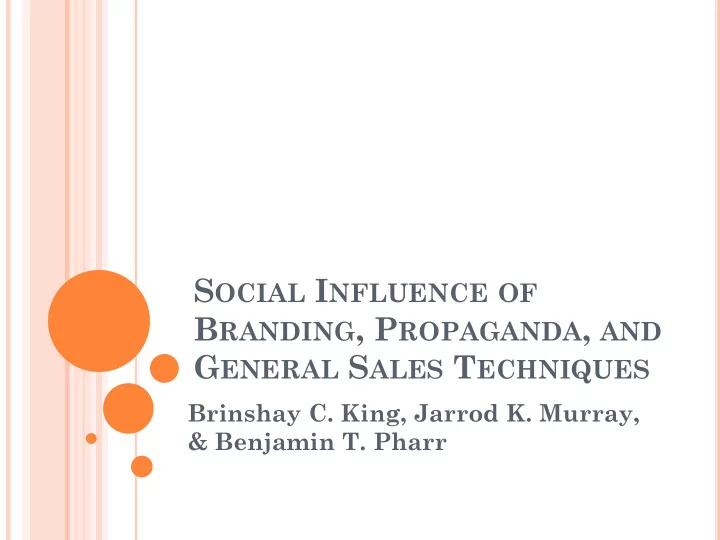

S OCIAL I NFLUENCE OF B RANDING , P ROPAGANDA , AND G ENERAL S ALES T ECHNIQUES Brinshay C. King, Jarrod K. Murray, & Benjamin T. Pharr
W HAT I S A B RAND ? A brand is a type of product manufactured by a company under a particular name Brands can be associated with symbols or logos Brands can be used to create a company’s personality
C LASSICAL C ONDITIONING Classical conditioning can be thought of as learning by association Classical conditioning allows consumers to pair their thoughts and feeling to a particular brand Rarely does a company change a slogan that represents its brand
S TIMULUS G ENERALIZATION Stimulus generalization is the tendency for stimuli that are similar to the conditioned stimulus to elicit a conditioned response Brands such as Kleenex and Band-Aid can be associated with stimulus generalization
P ROPAGANDA Information, ideas, or rumors deliberately spread widely to help or harm a person, group, movement, institution, nation, etc. War propaganda is the most recognized form of propaganda There are different types and techniques
P ROPAGANDA War time propaganda:
P ROPAGANDA Common techniques that will be researched: Word Games Name-calling Glittering generalities Euphemisms False connections Transfer Testimonials
P ROPAGANDA Common techniques that will be researched (cont.): Special appeals Plain folk Bandwagon Fear Logical fallacies Bad logical connections or propaganda?
S ALES T ECHNIQUES Salesperson behavior Mirroring Foot in the door technique That’s not all technique Call to action Authority
S ALES T ECHNIQUES Commercial techniques Slogans Heuristics Scarcity Anchoring Role of social status Brand recognition Ostracism Group membership
P ROJECT G OALS To discuss the psychological underpinnings behind branding, propaganda, and sales techniques To create an interactive website, including various examples, links to research, and multimedia, to explore the use of psychology in our areas of research To provide a resource for students and faculty who are either well acquainted with social psychology or those who are exploring social psychology for the first time
Recommend
More recommend